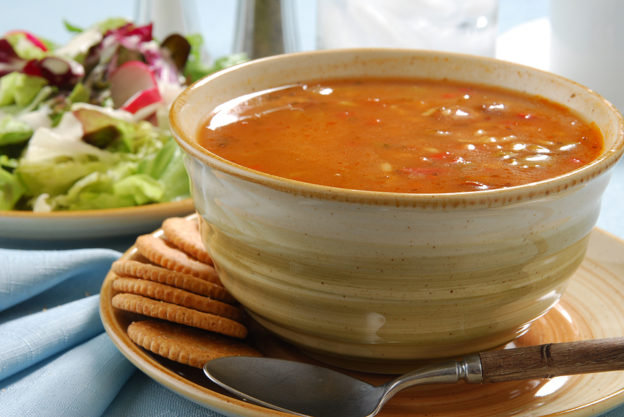By David Blyweiss, M.D., Advanced Natural Wellness
August 14, 2020
It’s 11am and you’re at the office. That’s when the chatter begins…
“Do you want Chinese again today?”
“Oh no. Let’s order Mexican instead.”
“Hey guys! Janie says she’s running out for salads.”
“Oh! That sounds good. Does anyone remember today’s soup-of-the-day?”
In my younger days I was always on board for these lunch fiestas. What followed was a lunch room filled with delicious food from the local restaurants.
Nowadays, a lot more people are working from home. But still, it’s easy to punch a few buttons on your phone so food magically appears on your doorstep.
Back in the day, I used to pick up meals on my way home from work. I also enjoyed taking my family out to dinner on the weekends.
That was before I knew better.
That was before I started my education as a functional physician.
You see, once I began my medical training I started to view this restaurant food differently. Yes, food can be the best medicine in the world… but it can also kill you.
Believe me, it was a shock when I first discovered the harm I was causing myself and my family with all of these food outings.
So, what’s the big deal?
MD Exposes the Hidden Danger to Your Eyes

When your eyesight starts to fail, it's a real problem. Suddenly you can't go to the grocery store... you can't get to the doctor if you have an emergency... you can't meet your friends for dinner…
Your "regular" doctor doesn't have time to keep up with the latest research. And the same goes for eye doctors. They go to school to learn how to fit you for glasses and contacts, but have no way of preventing the damage and loss of eyesight that threatens your freedom and independence.
Let me show you something that explains a LOT about how your eyes work.
In my FREE Special Report, I'll show you a HUGE, untapped resource for your eyes that safely and naturally restores clear, effortless eyesight.
Click here to get started...
Well, the first problem is glaringly obvious. It’s all of the salt, sugar and unhealthy fats found in restaurant foods. Even though I always chose menu items that sounded healthy, a little research showed me how wrong I had been.
I’ll give you a very simple example:
Let’s say you go to Olive Garden and want to select what you think are the healthiest items on the menu.
What would you choose?
Well, you can’t go wrong with their signature salad, right? And out of all the soups, minestrone has the most veggies in it. So that would likely be the healthiest soup choice.
Soup and salad sounds like a light option, so you decide you can splurge (just a little) on a dessert.
Mmm… maybe a warm apple tart would be a good choice? It contains fruit, so surely it’s better than those other options packed with refined sugar and flour.
After a satisfying meal, it’s time to take a closer look at what you just ate. It probably wasn’t too bad, right?
Well I hate to burst your bubble, but you’ve just dealt your body a harmful blow.
First off, you exceeded the ideal limit of 1,500 mg of sodium per day. You’ve also bypassed the recommended sugar intake of less than 25 (women) to 37.5 (men) grams daily. So, you just ate more than your allotted 8-12 teaspoons of sugar for the day.
You also just dosed your body with inflammatory omega-6 fatty acids and other unhealthy additives.
Here are the stats…
| MENU ITEM | SERVING SIZE | Sodium | Sugar |
| Salad with Signature Dressing | 5 ounces | 770 | 4 |
| Minestrone Soup | 8 ounces | 810 | 4 |
| Warm Apple Crostata | unknown | 420 | 41 |
| TOTALS | 2000 | 49 |
Source: Olive Garden Italian Kitchen Nutrition Information
Are You Suffering From...
- Love handles and a pot belly
- Romance that isn't what it used to
- Forgetfulness and inattention
- Low (or no) strength and endurance
- A sex drive that's shifted into neutral...or worse
If so...you may have Mature Male Burnout. Click here to discover more about this unique condition and what you can do about it.
And remember, these numbers are for a single serving of each… no breadsticks included. So just imagine what happens when you take part in the unlimited soup, salad and breadstick lunch option!!!
On its own, this information is enough to make anyone reconsider eating out. But the dangers go well beyond that.
Restaurant Foods are Riddled with Chemicals
Years ago, we discovered that people who frequently eat at restaurants, cafeterias or fast-food joints have phthalate levels nearly 35% higher than people who enjoy meals cooked at home.
These are toxic chemicals that disrupt endocrine function and interfere with hormone production. They’re also associated with all sorts of health problems including breast cancer, type 2 diabetes, obesity, asthma and attention-deficit hyperactivity disorder.
And today there is even more bad news.
There is another class of chemicals, called per- and polyfluoroalkyl substances (PFAs), that also tend to build up in the body. They’ve been linked to cancer, thyroid disease, immune suppression, low birth weight, and decreased fertility.
Well guess what? People who eat most of their foods cooked at home have much lower levels of these dangerous compounds in their bloodstream than those who eat out.
So, what are the restaurants doing wrong to increase the harmful chemicals in their foods?
It all comes down to preparation and packaging. Restaurants foods are more likely to have extended contact with a variety of food packaging and wraps that contains PFAs and phthalates. These chemicals tend to leach from the packaging into the foods inside. They can also be transferred to food during processing.
Foods at the grocery store that come in packages, plastics and wraps will also contain levels of these compounds. (One of the worst, by far, is microwavable popcorn bags. People who eat popcorn regularly from these microwavable bags have about a 63% increase in PFA levels over the course of a year.)
Now you can’t avoid these chemicals altogether, but you can limit your exposure.
Save eating out for special occasions. Not only will you be all the healthier for it, you’ll also enjoy your dining experience more when it’s not a regular event.
I also recommend bypassing the packaged and processed foods at the grocery store. Fresh, organic, home-made foods are a much better choice for your snacks and meals. And they don’t have to take hours to prepare.
It usually only takes about 15 or 20 minutes on Sunday evenings for me to throw together a big salad of some sort. It might be spinach, tomatoes, peppers, nuts and avocado. Or it could be a fruit salad. That’s my lunch for the week.
On weekdays it takes even less time to whip up an egg and vegetable scramble or frittata. (In a pinch, I can always grab a plain, organic Greek or coconut yogurt and add my favorite fruits, berries, or chia seeds. I might add some cinnamon or nutmeg for a great chia pudding.
Baked or broiled vegetables or a veggie stir fry are both super-quick dinner options. They only take about 15 minutes. Adding fresh, wild-caught fish, shellfish or a pasture-raised chicken filet doesn’t add any more time to the prep either.
So go for it!
SOURCES:
Varshavsky JR, et al. Dietary sources of cumulative phthalates exposure among the U.S. general population in NHANES 2005–2014. Environment International. Available online 29 March 2018.
Hsieh TH, et al. Phthalates induce proliferation and invasiveness of estrogen receptor-negative breast cancer through the AhR/HDAC6/c-Myc signaling pathway. FASEB J. 2012 Feb;26(2):778-87.
Stojanoska MM, et al. The influence of phthalates and bisphenol A on the obesity development and glucose metabolism disorders. Endocrine. 2017 Mar;55(3):666-681.
Tsai MJ, et al. The association between phthalate exposure and asthma. Kaohsiung J Med Sci. 2012 Jul;28(7 Suppl):S28-36.
Chopra V, et al. Association between phthalates and attention deficit disorder and learning disability in U.S. children, 6–15 years. Environ Res. 2014 Jan; 128: 64–69.
National Research Council (US) Committee on the Health Risks of Phthalates. Phthalates and Cumulative Risk Assessment: The Tasks Ahead. Washington (DC): National Academies Press (US); 2008.
Susmann HP, et al. “Dietary Habits Related to Food Packaging and Population Exposure to PFASs,” Environmental Health Perspectives. 2019 Oct; 127(10).







